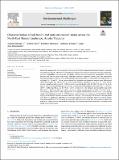| dc.description.abstract | Soil fertility management has been a great challenge to smallholder farmers in the Northern Tanzania, especially
in the Maasai landscape. Therefore understanding the nutrient status become important to forecast productivity,
promote sustainability, and propose an appropriate technique for crop productivity sustainability. The study
examines soil fertility status of the Maasai landscape. Systematic approach known as the Land Degradation
Surveillance Framework (LDSF) were used to identify soil sampling points. A total of 604 soil samples from two
soil depth (0 – 30 and 30 – 50 cm) were collected for physiochemical properties analysis using Mid-infrared
(MIR) spectroscopy. The chosen level for determining statistical significance, was set at P = 0.05. Results
showed a significant differences (P < 0.01) for particle size distribution, SOC, EC, CEC, TN, pH, N, P, K, Ca, S,
Mg, Mn and Zn across the landscape zones. It was observed that soil parameters such as pH (6.62 – 7.44), CEC
(27.59 – 32.82 meq/100 g), and EC (90.12 - 121.93 μS/cm) were in the adequate and acceptable range while
SOC (0.89 – 1.89 %) was observed to be in low amount. Other nutrients such as N (0.09 – 0.14 %), P (9.46 –
14.87 mg/kg), and K (175.91 - 293.5 mg/kg) were in inadequate amounts except for the S (12.9 – 15.43 mg/kg)
which was in optimum, Ca (3117.5 - 4155.31 mg/kg) ranged between low to optimum, and Mg (556.95 - 603.26
mg/kg) was in excessive amounts. However, Mn (114.13 mg/kg – 128.95 mg/kg) was in excess. This study found
that, there is a significance difference on soil fertility status across the landscape. Major soil nutrient fertility
constraints found were N, P, Ca, and K for some soils. The study recommends that interventions to address the
issue of soil fertility in the northeast Maasai landscape should consider the altitude issue due to variations in soil
health and nutrient content. | en_US |

